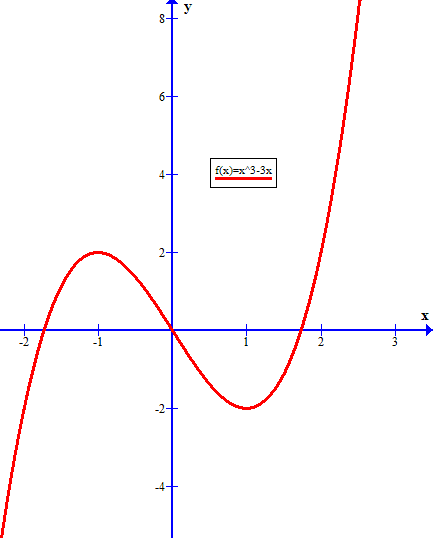How to solve this? Find #m in RR # for which #X^3-3X+m=0# has a double root.
4 Answers
Explanation:
Given:
#x^3-3x+m = 0#
Here's one method:
Suppose the roots are
Then:
#x^3-3x+m = (x-alpha)(x-alpha)(x-beta)#
#color(white)(x^3-3x+m) = x^3-(2alpha+beta)x^2+(alpha^2+2alphabeta)x-alpha^2beta#
Equating coefficients, we have:
#{ (2alpha+beta = 0), (alpha^2+2alphabeta = -3), (-alpha^2beta = m) :}#
From the first equation, we have:
#beta = -2alpha#
Substituting this into the second and third equations, we find:
#{ (-3alpha^2 = -3), (2alpha^3 = m) :}#
From the first of these equations we find:
#alpha^2 = 1#
and hence:
#alpha = +-1#
Then from the second:
#m = 2alpha^3 = +-2#
Explanation:
There are a couple ways to approach this once we recognize that "having a double root" is equivalent to having a slope of zero.
Graphically, if we consider the simpler relation:

we can see that the relation has turning points at
That is the relation has a double root when
and when
Using Calculus
A slope of zero implies that the derivative is equal to zero at that point.
If
then the slope is zero when
Substituting
gives the solution values for
Explanation:
Here's another method using the discriminant...
The discriminant
#Delta = b^2c^2-4ac^3-4b^3d-27a^2d^2+18abcd#
The cubic will have repeated roots if and only if
#x^3-3x+m = 0#
is in the form:
#ax^3+bx^2+cx+d = 0#
with
So:
#Delta = b^2c^2-4ac^3-4b^3d-27a^2d^2+18abcd#
#color(white)(Delta) = color(red)(cancel(color(black)((0)^2(-3)^2)))-4(1)(-3)^3-color(red)(cancel(color(black)(4(0)^3(m))))-27(1)^2(m)^2+color(red)(cancel(color(black)(18(1)(0)(-3)(m))))#
#color(white)(Delta) = 4*27 - 27m^2#
#color(white)(Delta) = 27(2^2-m^2)#
#color(white)(Delta) = 27(2-m)(2+m)#
So
Explanation:
Another method
if a cubic has a repeated root
differentiating
ie for a repeated root
so we have
solving


